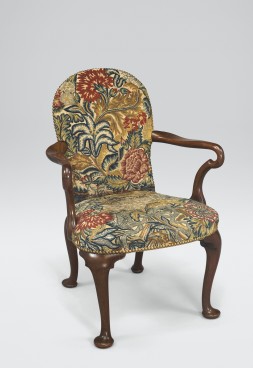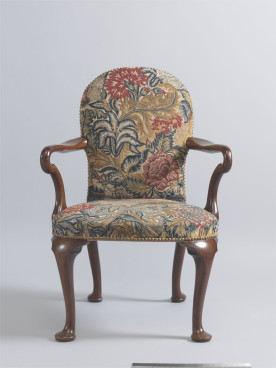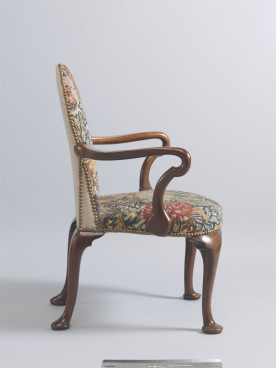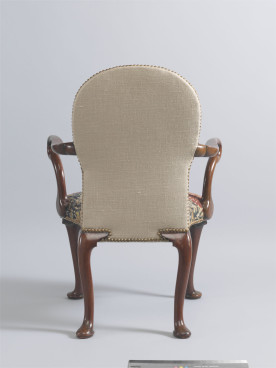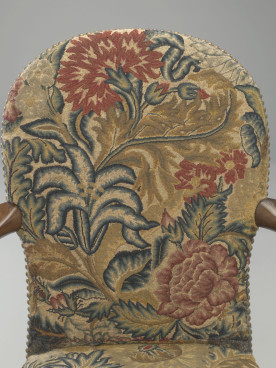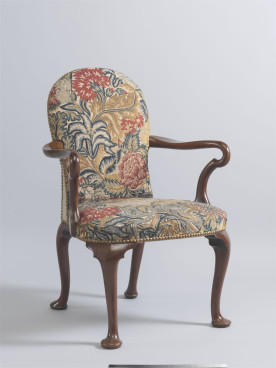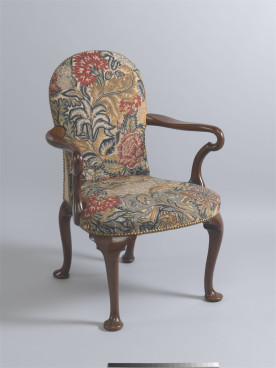Armchair, c.1720–35
Walnut, now with 18th-century needlework
Adam Bowett Catalogue (19/08/2012)
Description
An upholstered armchair, c. 1735-40. The compass back and seat are covered with contemporary silk (?) and wool (?) needlework, close-nailed around the seat rail. The back is closed with buff-coloured cloth (modern), and also close nailed. The outcurved ‘shepherd’s crook’ arms are raised on backward-curving supports, and the seat is raised on cabriole front and back legs with pad feet.
Dimensions
H: 34 ½ ” (88cm) Seat height: 16 ½ ” (42cm) W: 21 ½ ” ( 55cm) D: 22 ½ ” (57cm)
Materials
Mahogany arms and legs with beech seat rails and softwood reinforcing blocks to the front legs. Oak blocks to the back legs. The frame of the back is presumably beech but obscured by upholstery.
Dating criteria
‘Compass’ (i.e., rounded) seats and backs were introduced from about 1720. The ‘shepherd’s crook’ arms are often thought to be an early feature but the use of mahogany probably points to a date in the 1730s or even early 1740s.
Construction
Details of the seat construction are obscured by reinforcing blocks and repairs. The seat rails are possibly half-lapped at the front corners and the front legs either tenoned or dovetailed up into them. The side rails are tenoned into the back legs as is the back rail. Each front leg is supported by two shaped mahogany brackets with a further shaped softwood block behind. The brackets were probably originally glued and are now screwed. The back legs also have added brackets strengthened by a shaped oak block behind. The arms are constructed in two parts, the upper part is probably screwed into the back frame, the lower part is screwed with two screws into the side rails; the joint between the upper and lower sections is probably secured with a mortise-and-tenon. Construction of the back is conjectural because fully enclosed by upholstery.
Condition
The chair has clearly seen heavy use; both arms have been detached and re-fixed to the seat rails, the left arm in particular has been damaged and repaired at that point. There is also a repair at the junction between the left arm and the back. Both arms have suffered some damage to the joints between upper and lower sections, the right one being repaired with a spliced-in section of new wood. Both back feet have been broken and repaired, the brackets removed and reset, both oak support blocks replaced. The joints between the front legs and the seat rails have been extensively repaired and bandaged with hessian/scrim, the softwood support blocks are replaced, mahogany brackets have been detached and re-fixed with screws, with splits and other damage. Both front feet repaired.
Additional remarks
Needlework to be studied by specialist. This is probably a dressing chair.
References
For dressing chairs, see Lucy Wood, Upholstered Furniture in the Lady Lever Art Gallery, 2 Vols., New Haven and London (2008), I, pp. 38-40; Adam Bowett, Early Georgian Furniture 1715-1740, Woodbridge (2009), pp. 188-189.
Provenance
Purchased from Mallett, October 2003

